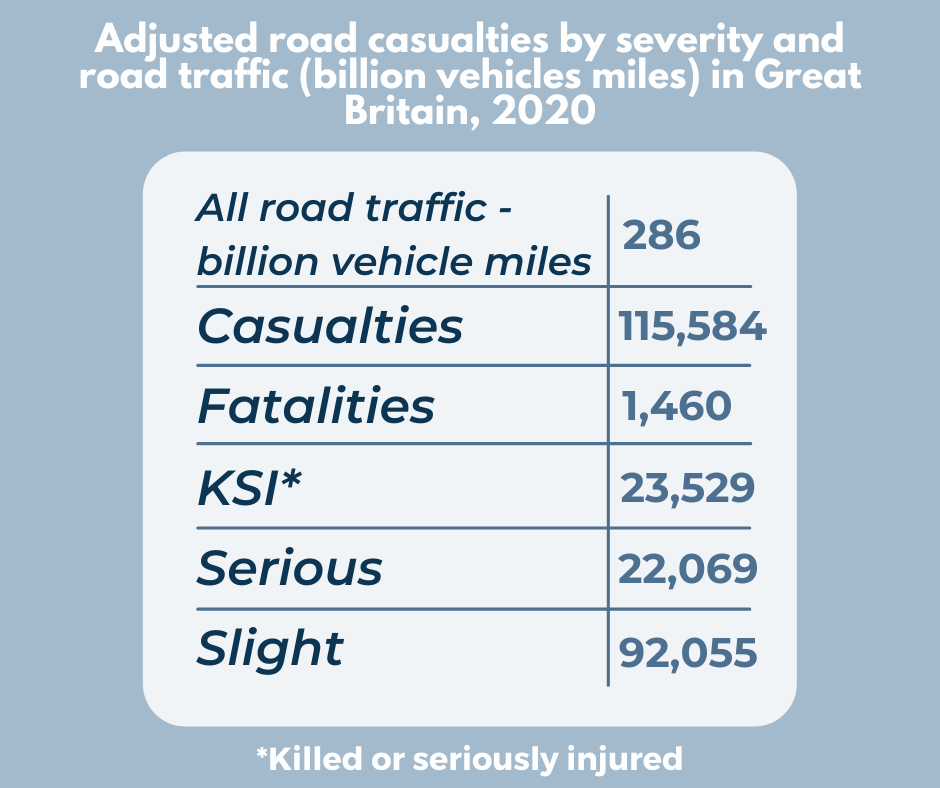As part of November’s Hazard of the Month, we’re highlighting two key areas: Driving Safely and Lone Working.
Driving Safely
 Despite travel restrictions as part of the Government’s COVID-19 response causing a reduction in road casualties and fatalities, reported numbers were still alarmingly high – with 115,584 reported casualties and 1,460 reported deaths reported in 2020. Road safety is vitally important for all road users, whether you drive for work or only use your vehicle in your own time.
Despite travel restrictions as part of the Government’s COVID-19 response causing a reduction in road casualties and fatalities, reported numbers were still alarmingly high – with 115,584 reported casualties and 1,460 reported deaths reported in 2020. Road safety is vitally important for all road users, whether you drive for work or only use your vehicle in your own time.
If you drive for work, your employer is responsible for managing health and safety risks you may face. However, when out on the road alone, you must keep in mind:
- Adjusting your driving technique for different types of road
- The effect of your individual behaviour when driving
- General observation and awareness when driving
- Your individual responsibility on the road
- The importance of reporting working related driving issues to your employer
- How to handle difficult weather conditions
Employers are responsible for ensuring you have the training you need to do the above – our Driving Safely Awareness course can help increase your awareness of how your behaviours on the road can affect how safe a driver your are.
Make sure your workers have an awareness of safe road user behaviours with our Driving Safely E-Learning course – this course is suitable for individuals who drive within the UK as part of their job, those who regularly drive outside of work, or individuals who need a bit more confidence on the road. Get 10% off this course with the code ‘driving10’!
Lone Working
 With more people working alone than ever due to the increase in remote and home-working, many people fall under the umbrella of ‘lone worker’. Due to the nature of lone working, employees who work alone face greater risks as they lack direct supervision or other colleagues to rely on if something goes wrong.
With more people working alone than ever due to the increase in remote and home-working, many people fall under the umbrella of ‘lone worker’. Due to the nature of lone working, employees who work alone face greater risks as they lack direct supervision or other colleagues to rely on if something goes wrong.
Lone workers are especially susceptible to certain types of risks. Some risks that particularly affect lone workers include:
- Violence in the workplace – lack of nearby support makes it harder for a lone worker to prevent an incident.
- Stress and mental health or wellbeing – lone workers may feel isolated, and may struggle to get proper support due to being away from managers and colleagues.
- A person’s medical suitability to work alone – routine work along with potential emergencies which could put additional physical and mental burdens on the lone worker must be considered. Some types of lone workers, such as HGV drivers, have specific work-related risks to their health.
- The workplace itself – rural or isolated areas may pose a higher risk to lone workers.
Despite being based in a familiar home setting, employees who work from home also face lone working risks. Therefore, employers still have the same level of health and safety responsibilities as they would for any other worker, and so must:
- Provide supervision
- Provide education and training
- Implement control measures to protect the homeworker
Enrol onto our Lone Working E-Learning course to learn the risks of lone working, safe practises for working alone, and more! This course is suitable for for managers or any employees who will be involved in lone working, senior management involved in lone worker safety, and anyone who works at home or remotely. Get 10% off this course with the code ‘driving10’!

Driving Safely and Lone Working training is relevant to many workers – if you drive for work you’re highly likely to have times where you work alone, and working from home has become much more prevalent. Make sure you don’t miss out on our 10% off deal on these essential safety courses, available until the end of November. Simply enter the code ‘driving10’ at checkout to save!
To keep up to date with the latest health & safety news and advice, follow us on social media:
